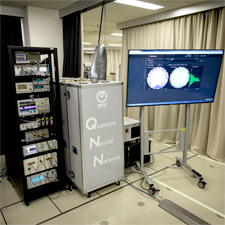Quantum Neural Network on Cloud

Nippon Telegraph and Telephone Corporation, the National Institute of Informatics (NII), and the University of Tokyo will open a Quantum Neural Network (QNN), a new computer utilizing the quantum nature of light, to the public as a cloud service on the internet.
The systems and networks in our society, such as the internet, wireless communications networks, and traffic systems, are increasing in scale and complexity, so their optimization is becoming increasingly important. The QNN uses the quantum characteristics of a new type of laser, called an optical parametric oscillator (OPO), to instantly find solutions to combinatorial optimization problems. The research team constructed a cloud system that enables access to the QNN system through the internet from all over the world. With this QNN cloud system, users can experience extremely fast computation of large-scale optimization problems. The team expects that the QNN cloud system will accelerate the research and development of QNN applications. This project has been undertaken in collaboration with Osaka University.
=> Press Release
=> Quantum Optical State Control Research Group
Quantum Neural Network (QNN)
Figure 1(a) shows a schematic of the setup of the QNN, which is based on an optical fiber cavity comprising a 1-km-long optical fiber and an optical phase sensitive amplifier (PSA). Thousands of pulsed OPOs generated by switching the PSA on and off at gigahertz frequencies travel in the cavity. Interactions among the OPO pulses are adjusted according to an optimization problem. After multiple circulations of OPO pulses in the cavity, their phase configuration becomes the best so as to stabilize the entire OPO network. The phase configuration corresponds to a solution to the optimization problem. Since arbitrary pairs among 2000 OPOs can be constructed by a measurement and feedback scheme, the QNN can find solutions to 2000-node combinatorial optimization problems in a very short time.
In our previous research, the QNN was constructed on a large table as a proof-of-principle experimental setup. We have now developed a rack-mountable QNN system for the cloud service [Fig. 1(b)]. By improving the phase stabilization of the optical circuit and implementing precise temperature control of the 1-km-long optical fiber cavity, we have achieved continuous operation of the QNN for more than a week.
QNN Cloud system for computation experience
We will open the QNN system to the public so that users around the world can experience the computation on it. The QNN Cloud system consists of a web application server managed by NII and the QNN system located at NTT Basic Research Laboratories. This system enables general users with no expertise in complex optical experiments to experience QNN computation. In the first release, users can find solutions to large-scale maximum cut problems of all-to-all connected graphs with up to as many as 2000 nodes.
Link to the QNN Cloud system










